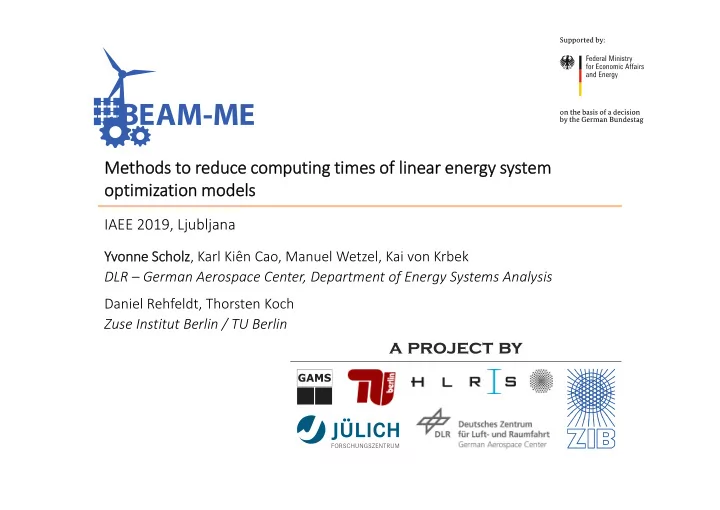

Methods to reduce computing times of linear energy system optimization models IAEE 2019, Ljubljana Yvonne Scholz , Karl Kiên Cao, Manuel Wetzel, Kai von Krbek DLR – German Aerospace Center, Department of Energy Systems Analysis Daniel Rehfeldt, Thorsten Koch Zuse Institut Berlin / TU Berlin a project by
Approach I: Model-based computing time reduction Solver parameters Solver-based Solving methodology Speed-Up strategies Pure model reduction Heuristic decomposition Model-based Exact Decomposition
„Low Hanging Fruits“ Solver parameters Solver-based Solving methodology Speed-Up strategies Pure model reduction Heuristic decomposition Model-based Exact Decomposition
Source code improvement • Selection of measures (also useful to decrease memory need): – Input data should not differ much in its order of magnitude – Index order influences computing time • Useful, but not necessarily faster • Assignment statements with a different set order can be faster • It can be better to place large index sets at the beginning – Use of “option kill” , e.g. for long time-series input parameters saves memory – Abundant use of “Dollar Control over the Domain of Definition” – Consistent (and limited) use of defined variables – Avoid the consideration of technologies providing the same service at the same costs – Consider alternative formulation of model constraints (dense vs. sparse) • Helpful references : “Speeding up GAMS Execution Time” by Bruce A. McCarl https://www.gams.com/mccarl/speed.pdf 4 Yvonne Scholz (DLR)
Approach I: Model-based computing time reduction Solver parameters Solver-based Solving methodology Speed-Up strategies Pure model reduction Heuristic Decomposition Model-based Exact Decomposition
Presented speed-up approaches Representative time intervals Focusing regions of interest Slicing Neglecting technologies Pure model reduction Temporal downsampling Rolling time horizons Spatial downsampling (building network Aggregation equivalents) Myopic technology expansion planning Defining technology classes Heuristic “Spatial zooming“ decomposition “Temporal zooming” Increasing technological detail
Evaluation methodology
Evaluation: Overview Model name REMix Author German Aerospace Center (DLR) (Institution) Model type Linear programming minimization of total system costs economic dispatch / optimal dc power flow with expansion of storage and transmission capacities Sectoral focus Electricity Geographical Germany focus Spatial 488 nodes Solver Commercial resolution Algorithm Barrier Analyzed year 2030 Cross-over Disabled (scenario) Max. parallel 16 Temporal 8760 time steps (hourly) barrier threads resolution Scaling Aggressive 8 Yvonne Scholz (DLR)
Results
Results: Spatial aggregation Performance 10 Yvonne Scholz (DLR)
Results: Spatial aggregation Performance Accuracy 11 Yvonne Scholz (DLR)
Results: Spatial aggregation Performance Accuracy - Speed-up factor: ≈5 - Accuracy error mainly < 10 % (grids: ≈20%) 12 Yvonne Scholz (DLR)
Results: Temporal zooming Performance Accuracy 13 Yvonne Scholz (DLR)
Results: Temporal zooming Performance Accuracy - Speed-up factor: >10 reachable - Accuracy error of up to 35 % 14 Yvonne Scholz (DLR)
Approach II: Hardware-based computing time reduction … By Nikitarama - Own work, CC BY-SA 4.0, https://commons.wikimedia.org/w/index.php?curid=40358482
… and solver-based computing time reduction belong together! Solver parameters Solver-based Solving methodology Speed-Up strategies Pure model reduction Heuristic Decomposition Model-based Exact Decomposition
Preparing models for High Performance Computing Annotation I 17 August 28 th , 2019 Yvonne Scholz (DLR) Reducing Model Computing Times
Preparing models for High Performance Computing Annotation II - Annotation pre-structures the optimization problem - The GAMS interface permutes the matrix and builds model blocks for PIPS-IPM - The new solver PIPS-IPM can solve the problem parallelized on a supercomputer 18 August 28 th , 2019 Yvonne Scholz (DLR) Reducing Model Computing Times
Results The new PIPS solver Commercial Solvers: Poor scaling Time strongly depends on selected solver PIPS: New version is much faster (note that original PIPS was developed for different problems!) Scaling is almost linear Still in beta state! Issues: parallel preprocessing not suitable for all LPs 19 August 28 th , 2019 Yvonne Scholz (DLR) Reducing Model Computing Times
Conclusions
Conclusions • Model based speed-up strategies – Slicing / Aggregation / Heuristics / Decomposition – Computing time reduction up to factor 10 • Solver based speed-up strategies – ESM Annotation GAMS interface new PIPS solver HPC – Computing time reduction can reach > factor 100 – New PIPS solver still in beta state • BEAM-ME Best Practice Guide – publication planned by the end of 2019 – To be notified, subscribe to the mailing list: beamme-news@dlr.de subject: „subscribe“ 21 Yvonne Scholz (DLR)
Project BEAM-ME Thank you! Contact yvonne.scholz@dlr.de a project by
Recommend
More recommend